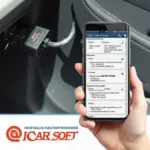OBD2 Bank 1 is a term that often pops up when dealing with car diagnostics, but what exactly does it mean? This guide will delve into the intricacies of OBD2 Bank 1, explaining its significance, common issues, and how it relates to your vehicle’s performance. We’ll cover everything from identifying bank 1 to understanding related OBD2 codes.
Understanding the layout of your engine is crucial for accurate diagnostics. In most vehicles with V-shaped engines (V6, V8, V10, etc.), the cylinders are divided into two groups, or “banks.” OBD2 Bank 1 typically refers to the side of the engine that contains cylinder number one. This is the standard convention for most manufacturers, although there might be exceptions. Knowing which side is bank 1 is essential for correctly interpreting diagnostic trouble codes (DTCs) and addressing any issues effectively. For inline engines (like a 4-cylinder), the concept of banks doesn’t apply as all cylinders are arranged in a single line.
Identifying OBD2 Bank 1 in Your Vehicle
How do you identify which side is bank 1? The most reliable method is to consult your vehicle’s service manual. This manual will provide a diagram of your engine layout, clearly indicating the location of cylinder number one and therefore, bank 1. Sometimes, the information can also be found on a sticker under the hood or on the engine itself.
Why is Identifying OBD2 Bank 1 Important?
Knowing which side is OBD2 Bank 1 is crucial for troubleshooting and repair. Many diagnostic trouble codes (DTCs) will specifically reference bank 1, such as obd2 code p1131 mercury mountaineer bank 1. This information helps pinpoint the location of the problem, whether it’s a faulty oxygen sensor, fuel injector, or another component. Without knowing which bank is affected, you could waste time and money replacing parts on the wrong side of the engine.
Common Issues Related to OBD2 Bank 1
Several issues can trigger OBD2 codes related to bank 1. These can include:
- Faulty oxygen sensors: Oxygen sensors in bank 1 play a crucial role in monitoring the exhaust gases and adjusting the air/fuel mixture. A malfunctioning sensor can lead to reduced fuel efficiency and increased emissions. Check out our article on obd2 codes p0155 for more information.
- Fuel injector problems: Issues with fuel injectors in bank 1 can disrupt the proper fuel delivery to the cylinders, leading to misfires and rough idling. A specific example of this can be seen with the 2002 ford f150 fuel bank to obd2 failure.
- Vacuum leaks: Vacuum leaks in bank 1 can affect the intake system, leading to a lean air/fuel mixture and other performance problems.
- Exhaust leaks: Leaks in the exhaust system of bank 1 can cause various issues, including increased noise and reduced engine performance.
- Ignition system problems: Issues with spark plugs or ignition coils in bank 1 can lead to misfires and reduced power.
Troubleshooting OBD2 Bank 1 Issues
When faced with an OBD2 code related to bank 1, the first step is to identify the specific code and its meaning. You can use an OBD2 scanner to retrieve the code and then consult a reliable resource like OBDFree to understand its meaning. Once you have a better understanding of the problem, you can begin troubleshooting. This may involve checking the relevant components in bank 1, such as the oxygen sensors, fuel injectors, vacuum lines, and exhaust system. You might encounter codes such as obd2 code p054c or obd2 code p2010 during your diagnostic process.
Expert Insight: “Knowing which side is bank 1 is essential for targeted diagnostics,” says John Smith, ASE Certified Master Technician. “It saves time and prevents unnecessary part replacements.”
Expert Insight: “Always consult your vehicle’s service manual for the precise location of bank 1,” advises Jane Doe, Automotive Engineer. “This ensures accurate troubleshooting and repair.”
In conclusion, understanding OBD2 Bank 1 is critical for effective car diagnostics and repair. By correctly identifying bank 1 and understanding the associated components and common issues, you can effectively address any problems that arise, ensuring your vehicle runs smoothly and efficiently. Remember to utilize resources like OBDFree for comprehensive information on OBD2 codes and troubleshooting.
FAQ:
- What does OBD2 Bank 1 mean? It typically refers to the side of the engine containing cylinder number one.
- How do I find bank 1 on my car? Consult your vehicle’s service manual.
- Why is knowing about bank 1 important? It helps pinpoint the location of problems for accurate diagnostics.
- What are some common problems associated with bank 1? Faulty oxygen sensors, fuel injector problems, vacuum leaks, and exhaust leaks.
- How do I troubleshoot OBD2 codes related to bank 1? Identify the code, consult resources like OBDFree, and check the relevant components in bank 1.
- What if I can’t find bank 1 information in my service manual? Consult a qualified mechanic or contact the vehicle manufacturer.
- Do all cars have a bank 1? No, inline engines typically do not have banks.
Need further assistance? Feel free to reach out to our dedicated customer support team via WhatsApp: +1(641)206-8880, Email: [email protected] or visit us at 789 Elm Street, San Francisco, CA 94102, USA. We are available 24/7 to help you. You can also explore other helpful articles on our website, such as those covering specific OBD2 codes and their troubleshooting procedures.
